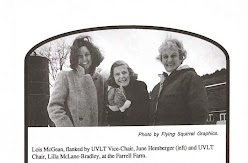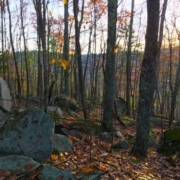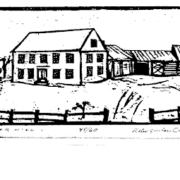Lois McGean Made History – Conservation and Housing in Vermont

Lois McGean, flanked by then UVLT Vice-Chair, June Hemberger (left) and UVLT Chair, Lilla McLane-Bradley, at the Farrell Farm
One of UVLT’s most complex conservation transactions is also one of our earliest – a project that brought together farmland conservation and affordable housing development. The Farrell Farm project, begun in 1988, involved the purchase of conservation easements and land, innovative financing including a grant and loan from the Vermont Housing and Conservation Board, subdivisions, Vermont Act 250 permits, and strong leadership and vision from Norwich residents. In the middle of all of this was Lois McGean, then chair of the Norwich Conservation Commission.
Lois had already made history on figure skates, winning the first ever world Ice Dance Championship in 1950 with Michael McGean, who became her husband two years later. The McGeans came to Norwich soon after, and Michael served as Dartmouth College’s Alumni Director for almost 40 years.
An ardent environmentalist and conservationist, Lois was involved in many aspects of civic life. You could find her at the school, organizing programs for students about nature. She was a passionate gardener who cared for her own landscape as well as community gardens. She was an advocate for strong land use planning and tried to stop the destruction of Lewiston village during the siting of Interstate 91. As a Conservation Commission member in the early 1980’s, Lois helped create and tabulate a 6-page natural resource questionnaire that served as a foundation for forming a conservation strategy for Norwich. Through the survey the Commission learned that 98% of respondents favored the Town accepting gifts of land of conservation easements and that 80% favored an annual appropriation for the purchase of important lands.

Farrell Farm and Starlake Village April 27, 2021
The Farrell Farm project was the first in the state to envision and pursue combining protection of a working farm and construction of significant affordable housing on the same site. Lois McGean was one of the project’s earliest supporters and she was crucial for mobilizing community support. When so much seemed unknown and untried, Lois was eager to learn, absolutely determined, and resolutely generous in her approach. She was a sparkplug of positivity despite her own declining health.
A September 1989 newsletter described, “Two local committees were formed: a six member steering committee, which met often to help define broad goals and map a strategy; and a fundraising committee to inform everyone in Norwich of the opportunity to provide both affordable housing and farmland protection and to solicit financial support for the effort.” Lois served on both.
After seven public meetings, 61 households provided charitable credit (legal promises that could be used to secure borrowing and would be prorated to cover a portion of a shortfall should one occur). UVLT’s grant application to the Vermont Housing and Conservation Board was accompanied by support letters from all the region’s state representatives and senators. Norwich residents contributed cash and the town approved a municipal appropriation. UVLT carried a loan for several years while Twin States Housing Trust (now Twin Pines Housing Trust) obtained its own financing and permits. In 1993, Governor Howard Dean came to Norwich for the ribbon cutting and groundbreaking at Starlake village where 14 perpetually affordable homes were built.
Sadly, Lois did not live to see the ribbon cutting and loan payoff and the conservation of the last parcels of farmland. Her family and friends established a UVLT endowment in her honor. Income from the Lois McGean Fund has supported important land conservation projects in Norwich and surrounding towns over the past 35 years.









